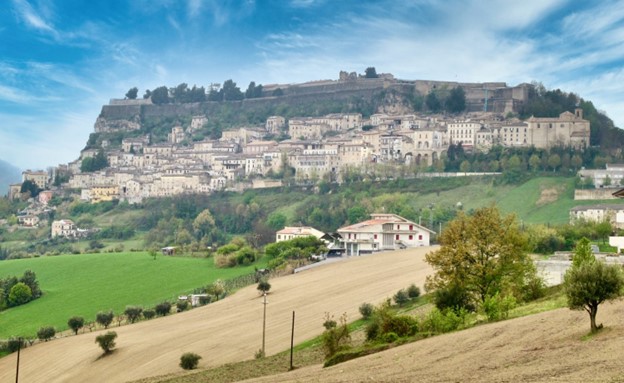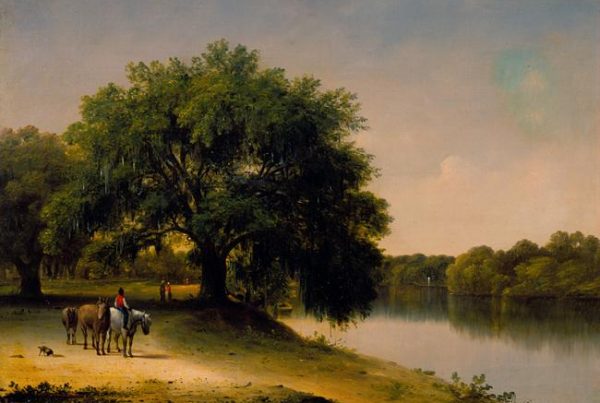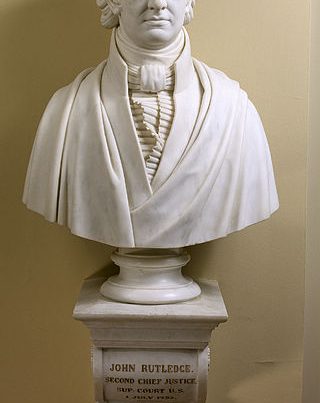The Confederacy and Naples
Some years ago (summer 1974) when I was completing a doctorate in history and political science in Europe, I made a journey south from Rome to the Italian city of Naples. Earlier, before traveling to Europe on a Richard Weaver Fellowship, I had managed to read two engrossing volumes on the Bourbon monarchy of the Kingdom of Naples by Sir Harold Acton. The old Kingdom of Naples (or of “Two Sicilies,” as it was formally called) had been conquered by the freebooter Giuseppe Garibaldi and his “Red Shirts,” in cooperation with the northern, liberal Italian Kingdom of Piedmont Savoy, in the early months of 1861.
That resolutely traditionalist country, basically all of southern Italy and Sicily, fascinated me. The Neapolitan kingdom was perhaps the most anti-liberal, traditionalist nation in all of Europe prior to it disappearance by conquest into the new centralized Italian state. Its capital, Naples, was an international center of culture and brilliance; musicians, composers, writers, and artists from all round Europe congregated there. All of that would end after Italian occupation. And southern Italy, “Due Sicilia,” would descend into an extended era of poverty, subjugation, and eventual neglect, much like that inflicted on the states of the Confederacy after the War Between the States.
But what was more intriguing for me was to learn that after the surrender of King Francis II and his small Neapolitan army at the fortress of Gaeta in late February 1861 (after an heroic four month siege), several thousand army regulars of the Royal Neapolitan Army clandestinely boarded ships, evaded a British cordon, and managed to sail for New Orleans to volunteer for the newly-formed Confederate Army. The first ships arrived from Naples with 884 former members of army of the Kingdom of Two Sicilies to take up arms for the Confederacy in early 1861. That number of Neapolitan volunteers soon rose to approximately 2000.
Initially, they were enlisted in several Louisiana Confederate units, including the 10th Louisiana Infantry and eventually other regiments, including a European Brigade which counted traditionalist Catholic volunteers from Spain (mostly royalist Carlists, who arrived by way of Mexico), France (French Legitimists, supporters of the old French Bourbon monarchy), Ireland, and a few from Austria. There were Protestant volunteers, as well, with soldiers coming from England and German lands.
The Neapolitan volunteers fought at most of the major actions in the Trans-Mississippi. When the war ended, some returned to Italy, but others remained in the Southland, where their descendants continue to reside.
From Harold Acton I knew that the small Italian walled commune of Civitella del Tronto, atop a mountain in the Abruzzo region of central Italy, had been the last bastion of resistance to the northern Italian liberals, yielding finally on March 20, 1861. There in that remote mountain town is a museum (Museo delle Armi e Mappe antiche) dedicated to the history of armaments and the military of old Italy. And among its exhibits is a memorable one dedicated to the veterans who fought both for the long-gone Kingdom of Naples and also for the Southern Confederacy. A large Battle Flag is displayed (I assume it is still there) honoring those men, along with other items and relics. Both the Royal Neapolitan standard and the Battle Flag are customarily flown outside on occasion.
It was indeed one location I had to visit.
And it raised a question—why did those conservative, mostly Catholic traditionalists leave their home countries and come to the newly-created Confederate States of America and offer their services? What did they see in our new nation that convinced them to make such a sacrifice on behalf of a country not their own?
In reading European contemporary newspapers, correspondence, and journals from the period it became apparent to me that those men, that “band of brothers,” understood instinctively that the Cause of the South was an international cause, one which stood forthrightly against a headlong plunge into modernism, opposed to the worldwide ravages of revolution, liberal democracy and the eventual destruction of age-old customs and beliefs. The South they saw as a hierarchical society based in the real and absolute inequalities of Nature. The South stood against the encroachments of unrestricted capitalism and the philosophical underpinnings that supported that reality. The leaders of the South, albeit mostly Protestant, were descendants of the Cavaliers, and thus represented the best and noblest Americans, to be emulated and admired, as opposed to the Yankee scions of the New England Puritans.
Many of the foreign volunteers had already fought in struggles against liberalism in their own countries, and, as in the cases of Naples and Spain, had been on the losing side. This was the case with my Spanish friend, the Baron de Montevilla, whose ancestor fought both in Spain in the Carlist Wars, and later for the Confederacy. When an acquaintance asked his ancestor, “How can you justify fighting for two lost causes?,” he replied: “A lost cause is never really lost if the fight is for what is true and what is right.” (see “Paladins of Christian Civilization: The Universality of the Confederate Cause,” Confederate Veteran, September/October 2017 )
That very favorable view of the Confederacy and its leaders, if certainly debatable, was exemplified in the foreign conservative press by its glowing portraits of men such as Robert E. Lee, Pierre Gustave Toutant de Beauregard, Matthew Fontaine Maury, and Jeb Stuart, but also of such figures as the brilliant writer General James Johnston Pettigrew (whose volume Notes on Spain and the Spaniards is undoubtedly one of the finest and most philosophical “travel journals” that any American has written (and deserves to be more widely-known), “Stonewall” Jackson’s chaplain, Robert Lewis Dabney (whose writings are equally impressive), and various others.
The similarities between the defeated and prostrate South, and the defeated and downtrodden former Neapolitan kingdom are, in some ways, remarkable—not just in the losing wars forced upon them, but in the survival of memory and a continuing devotion to heritage.
Just as defenders of Confederate heritage, in organizations like the Sons of Confederate Veterans, the United Daughters of the Confederacy, and the Order of the Confederate Rose, are devoted to honoring their ancestors and defending the Cause for which they, in many cases, gave their lives, some southern Italians, descendants of those defenders at Gaeta and Civitella del Tronto, likewise seek to keep the memory and traditions of their forefathers alive. And in recent years, in active organizations such as the Associazione Culturale Neo-Borbonica (ACNB), they do exactly that all across the former territories of the ancient Kingdom of Naples.
Several years ago the ACNB issued a manifesto, a statement not only of principles but a summary of history. As you read the translation below (which I have tweaked just a bit), perhaps you will notice the dramatic analogies between the history of our Southland and of the Neapolitan lands, and why the cause of neither is yet extinguished.
Why We are Neo-Bourbons
On the cold afternoon of December 27, 1894, in the town of Arco, province of Trento, Francesco II of Bourbon, the last king of the Kingdom of Two Sicilies (Naples), died. The Bourbon dynasty no longer governed Southern Italy after a reign of 126 years. One hundred years after the death of King Francesco, no one remembers the Bourbons except as a negative symbol of the past. Never has history been so unkind and maliciously falsified as it has been with this king and with this dynasty. 126 years of prestige and of glory, of art and culture, of theatres and factories, of laws and achievements, of public works and archeological excavations, of order, of security, of riches, and of generosity have—all has been erased from our collective memory.
The Piedmontese from the North, with the self-interested complicity of the English and the French, invaded the peaceful Kingdom of the Two Sicilies, which extended from Latium [Rome] to Sicily over all of Southern Italy. Francesco II, at 24 years age, found himself fighting an unexpected and undesired war against his “Italian brothers”…. the Neapolitan army fought valiantly alongside its king and its heroic queen, Maria Sofia, who was barely nineteen. It surrendered after 93 days of siege at the fortress of Gaeta, at dawn on February 14, 1861. Thousands of heroic citizens of the Kingdom of the Two Sicilies died on the battlefield. In the same way, subsequently during the decade of the 1860s, thousands of men, women, and children perished in a reconstruction campaign against Southerners – they were called “bandits” or “brigands”, but they were, in fact, the last soldiers and defenders of a history, a tradition, and a culture that seemed to die with them forever.
But what were conditions before this fatal unification of Italy? Certainly, everything was not perfect, but it is worth noting that Naples was the capital of a kingdom born seven centuries earlier. Together with London, Paris and Vienna, Naples was an essential point of reference with regards to both political and cultural affairs in Italy and in Europe….
It is a fact that Piedmont carried away 80 million ducats cash from our banks (more than $ 1,000,000,000). It is a fact that we had more than 5,000 factories (among the great nations in the world). It is a fact that the streets of our beautiful cities were full of tourists that came from every part of the world. It is a fact that the Piedmontese made us pay more than twice the level of taxes we paid before unification. After unification, due to widespread hunger, more than five million emigrants left their families and homes and would never again see their native land. In the streets of our cities, we no longer saw tourists. Our factories were soon closed and still today we buy, eat, drink, wear, and use only products that come from Northern Italy. One cannot say today that Southern Italians live well; the average income of a Northern Italian is twice that of a Southerner; the ten poorest cities in Italy are all in the South. With unemployment, poor services, government crises, untenable immigration from Africa, and the collapse of a flawed political system, a rosy future for our children is highly unlikely. From the elementary school texts to those used by college students, we hear a tale much different than the truth. In 150 years, they have made us ashamed of being Southerners. They have said that our dialects were “vulgar”, that our traditions were uncivilized, that being a “Southerner” or a “Bourbon” meant being backward, nostalgic, ignorant, or uncivilized. We have begun, as Tacitus wrote two thousand years ago, to “admire their way of life, of dress or of speech, forgetting our own and thinking that theirs was civilization when it was only a ploy to dominate us.
Until 1860, the citizens of the Kingdom of the Two Sicilies were respected and esteemed in all the world because they were citizens of an ancient and prestigious kingdom…. We were respected and esteemed because we were subjects of a king that belonged to the Bourbon dynasty – an ancient dynasty but one capable of governing with wisdom and love. Upon all of this came the unbearable weight of the destruction of our historical consciousness, of our culture, of our traditions, and of our identity – the pain of the destruction of our white flags with gold fleurs-de-lis, our national anthem, and of all the symbols that were respected by the ancient and glorious Neapolitan nation. The Bourbons showed all the pride and dignity of being Southerners until the very end, when, on the earthworks of Gaeta, they behaved as heroes and fought night and day beneath the violent and incessant bombardment of the Piedmontese invaders. They wanted to defend, right until the end, 126 years of glorious and splendid history – 126 years of Bourbon civilization.
Francesco II left Naples amidst tears and embraces to avoid a massacre of his people – a people he knew so well, whose language was his own. Many people got rich with the unification of Italy, but not the Bourbons. Francesco II – little Francesco or “Franceschiello” as he was affectionately called – left his kingdom not taking with him one dime of money. The Italian government never gave back that which belonged to his family, and even today has never done so. Francesco II never returned to Naples. He died at age 58 in a hotel room in Arco di Trento [then part of Austria] comforted only by his great faith in God and by a profoundly Christian sense of acceptance, but without ever forgetting, even in the last days of his life, the country of his father and of his grandfather – his own native land. Only since 1984 does he lie next to his wife and his tiny daughter Maria Cristina in the Bourbon chapel of the Church of Santa Chiara in Naples. Few are those who remember him – he who was guilty only of having been on our side, among the defeated.
Why then be a Bourbon today? Because the time has finally come to understand who we were and who we can be. The time has come to begin to uncover our lost roots and to give to our children the roots they never knew – to give to them a sense of pride in being Southern Italian. To be a Bourbon means to understand history. To be a Neo-Bourbon means to have understood history with the desire and drive to construct a revived history on the base of the old for all the people of Southern Italy. Certainly the Bourbon period was not the “Golden Age,” and one cannot say we would have entered into a “Golden Age” if the Bourbons had continued to reign. But no one can deny that, during that cold winter of 161 years ago, the people of Southern Italy ceased to be a People. 161 years ago, Southern Italy ceased to be a nation. The historical memory and consciousness…began to be extinguished on the battlements of Gaeta.
Some may call us “nostalgic”, but how can one not be when one walks through the streets of our run-down and degraded cities or passes before our ancient buildings, churches, and monuments, now lost or forgotten? Yes, we are nostalgic and proud of being such, but our looking back serves a purpose. Now, more than ever, it is necessary to understand what are the real causes of our current problems in Southern Italy and how we can find the road toward a better future. The system and the ideology that have governed our politics and our culture for a century and a half have demonstrated that they are based on a deliberate lie. Southern politicians and intellectuals over the last century, closed off in isolation from the world around them, soiled the memory of the House of Bourbon of the Two Sicilies, but also demonstrated their incapability of representing or loving their own South.
Honesty, dignity, loyalty, courage, religious faith, wisdom, respect for history, love of art, affection for the land and the people of the Two Sicilies – these were the fundamental characteristics of all the Bourbon kings of Naples. Fortified by these examples and by these symbols we can and must liberate ourselves from the systems and ideologies that are already collapsing into ruins and which are responsible for having destroyed the past and the present of an entire people and of putting their future in jeopardy.
Let us recover our historical memory – recover our pride in being Southerners – and walk together on the long road towards the salvation of our ancient nation and of our ancient dignity.(ASSOCIAZIONE CULTURALE NEO-BORBONICA http://www.neoborbonici.it/portal/ )
*****
The defenders of heritage and memory, in both the American South and the Italian South, remember who they are and where they come from. And despite defeat, suppression and scorn, and unceasing attacks on their culture and history, they intuitively understand, as Spanish writer Miguel de Unamuno expressed it in his volume, The Tragic Sense of Life, “Our life is a hope which is continually converting itself into memory and memory in its turn begets hope.”
[NOTE: Just as “Dixie” is the unofficial national anthem of the American Southland, so in the old Kingdom of Naples, the “Inno Nazionale Regno delle Due Sicilie” (National Hymn of the Kingdom of the Two Sicilies) remains popular as a symbol of Southern Italian history, heritage, and resistance: https://www.youtube.com/watch?v=H2xdGRUW8-g ]







This is absolutely fascinating. More than that, without the unification of Italy, the country would not have been able to fight in the two absolutely disastrous wars of the 20th Century. No Garibaldi, no Mussolini. That ought to be part of the historical equation.
I have enjoyed reading mr. Cathey for years, However i have grown tired of the catholic hatred of the puritans. I know there is a long history of hate between the two. The yankees that prosecuted the war against the South starting in 1861 and ending when God judges the earth. The yankee that invaded the South Never had a Puritan spirit.
Amazing comparison! It is sad how closely their experience parallels our own. We love the South and our Southern brothers and sisters! Thank you, Mr. Cathey, for sharing your wealth of knowledge.
Where can I learn more about these defeated Italians of their own South?